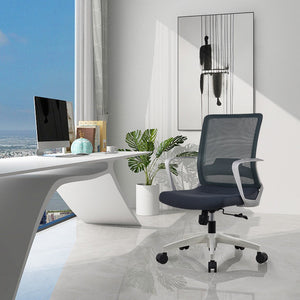Designed for comfort and built to last
Designed for comfort and built to last
Whether we work in an office or at home, many of us spend the majority of the day at a desk. A comfortable workspace is therefore essential for our health and well-being. Since we are all different shapes and sizes, it is important to have office furniture that can be customized to our personal needs. This brochure shows how we make your comfort our priority, and what you can do to achieve the best working environment.
Create the best workspace for you
It’s important to create the most comfortable working environment to suit you. Working for longer periods of time while sitting or standing in a bad or uncomfortable position can cause neck and back injuries as well as other serious health problems. Find out what you can do to create an ergonomic workspace, and learn about the different quality tests we carry out and the materials we use. What’s an ergonomic workspace? Ergonomics is about designing products or environments to make them safe and comfortable for people to use. An ergonomic workspace is one that is customized to your personal needs, allowing you to work in a comfortable and safe way.
Feel good and work better
We want to help you achieve an ergonomic working environment that suits you and promotes good health. This means adjusting the workspace to your needs, adopting an ergonomic position and keeping as mobile as possible. The human body is made to move, so ideally, your workspace should give you the choice of sitting, standing and leaning, allowing you to change positions often. And if you feel good at work, you will work better.
Some tips:
Choosing the right chair, desk, monitor or lamp can help create a comfortable working environment, but it cannot correct bad posture. Make sure you adopt a good posture when sitting or standing for longer periods to avoid injury. Here are some tips on how to create a comfortable workspace.
1. SITTING
You should be able to stretch your legs under the table and turn 90° to the left and right for freedom of flexibility. The hips and knees should be at an angle of approx. 95-100° with your feet flat on the floor. HEIGHT Choose a height-adjustable chair. When standing, the highest point of the seat should be just below your knee cap. You should aim for an even distribution of weight. Raise your chair if you feel pressure near the back of your seat, but if you feel pressure near the front of your seat, you should lower your chair. This will improve the circulation of blood and reduce the risk of swelling. SEAT TILT Use the seat tilt to lock a position and to improve your comfort. It will affect the distribution of weight and can provide better stability and support when you need it. A tilt of 5° is recommended.
LUMBAR SUPPORT A chair with lumbar support will relieve the small of your back from tension caused by tiredness. The tilt of the back support should allow you to sit with your upper body slightly reclined (recommended 110°). ARMRESTS Armrests can provide support for the upper part of your forearms, and reduce the stress on your shoulders and back. Make sure that the armrests do not prevent the chair from being drawn close to the desk, nor restrict natural movements. Also keep in mind that soft armrests will be more comfortable for your elbows.
2. STANDING
A height-adjustable desk is ideal as it will allow you to change position often. Alternating between sitting and standing will reduce the risk of injury and increase circulation, as well as productivity. The top of your work surface should be elbow height and your elbows should be at a 90° angle when sitting or standing at your desk.
3. LEANING
A standing support enables a position between sitting and standing, and is ideal when you have a height adjustable desk. It has the following advantages: Provides freedom of movement for your upper and lower body. Activates and strengthens the core muscles of your body. Gives you an open posture which improves your circulation and metabolic rate.
4. MONITOR
Make sure your monitor is not placed too close to you. With your chair pulled in and arms stretched in front of you, you should not be able to touch the screen. The monitor should be placed directly in front of you, with the top just below eye level. Placing the monitor too high can cause neck problems. For longer periods at your monitor, make sure your arms and wrists are supported. The keyboard and mouse should be placed around 4-6" from the edge of the desk, so that the wrists are supported, but not too far that your neck and shoulders lean forwards. The monitor should be tilted at 20°-30°, which is an optimal angle for the eyes as well as the neck and shoulders.
Quality
We test our products for quality, safety and durability to meet international testing standards. We have very tight restrictions on chemicals, and even though certain products meet international standards they might not meet our own higher standards. In that case we will not manufacture those products. Your safety is always our top priority.
How we test our office furniture
Desk and desk chairs that are intended for home use are tested to assure they are comfortable, stable, safe and durable. The series of tests we put our desk chairs through are more rigorous to meet the strict requirements on stability, strength and durability. For instance, the chairs are subjected to heavy loads up to about 300 000 times. Desks for home use are subjected to various tests including stability, strength and durability tests. The kinds of tests that are carried out depend upon the design of the desk, and which areas of the desk that are expected to be most exposed to wear and tear. Tests carried out on desks for professional use are stricter than those for home use. Desks that meet those standards will adhere to the following standards: EN 527, ANSI/BIFMA X5, which means we test their stability, durability and safety. For example, we might test the strength of a product by subjecting it to a vertical force of 100 kg for 10 seconds×10 times.
Can take a tough day at work
A chair that is approved for office use fulfils high requirements on ergonomics, stability, strength and durability. We know, because we put the chair through many different tests and tough challenges. For example, we sized the chair according to both European and American measurement requirements, subjected it to heavy loads and tested the endurance of each part - up to 300,000 times. We did all this to make sure it would be comfortable to sit in, safe to use and capable of enduring full-time desk work - for many years.
A good day at the office
You work and feel better when you sit comfortably. VOFFOV swivel chair is tested for professional office use and therefore meets your requirements for safety, durability and stability. You can easily adjust the chair to suit your body and the built-in lumbar support relieves your back. The airy mesh fabric in the backrest lets air circulate and reduces the environmental impact of transport, as it makes the chair both lighter and more compact.
- algo office





